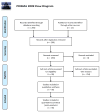Vagus Nerve Stimulation for Treatment of Inflammation: Systematic Review of Animal Models and Clinical Studies
- PMID: 29308423
- PMCID: PMC5756070
Vagus Nerve Stimulation for Treatment of Inflammation: Systematic Review of Animal Models and Clinical Studies
Abstract
Vagus nerve stimulation (VNS) has been used since 1997 for treatment of drug-resistant epilepsy. More recently, an off-label use of VNS has been explored in animal models and clinical trials for treatment of a number of conditions involving the innate immune system. The underlying premise has been the notion of the cholinergic antiinflammatory pathway (CAP), mediated by the vagus nerves. While the macroanatomic substrate - the vagus nerve - is understood, the physiology of the pleiotropic VNS effects and the "language" of the vagus nerve, mediated brain-body communication, remain an enigma. Tackling this kind of enigma is precisely the challenge for and promise of bioelectronic medicine. We review the state of the art of this emerging field as it pertains to developing strategies for use of the endogenous CAP to treat inflammation and infection in various animal models and human clinical trials. This is a systematic PubMed review for the MeSH terms "vagus nerve stimulation AND inflammation." We report the diverse profile of currently used VNS antiinflammatory strategies in animal studies and human clinical trials. This review provides a foundation and calls for devising systematic and comparable VNS strategies in animal and human studies for treatment of inflammation. We discuss species-specific differences in the molecular genetics of cholinergic signaling as a framework to understand the divergence in VNS effects between species. Brain-mapping initiatives are needed to decode vagus-carried brain-body communication before hypothesis-driven treatment approaches can be devised.
Conflict of interest statement
DISCLOSURE The authors declare that they have no competing interests as defined by Bioelectronic Medicine, or other interests that might be perceived to influence the results and discussion reported in this paper.
Figures
References
-
- Elliott RE, et al. Efficacy of vagus nerve stimulation over time: review of 65 consecutive patients with treatment-resistant epilepsy treated with VNS >10 years. Epilepsy Behav. 2011;20(3):478–83. - PubMed
-
- Uthman BM. Vagus nerve stimulation for seizures. Arch Med Res. 2000;31(3):300–03. - PubMed
-
- Bonaz B, et al. Chronic vagus nerve stimulation in Crohn’s disease: a 6-month follow-up pilot study. Neurogastroenterol Motil. 2016;28(6):948–53. - PubMed
Grants and funding
LinkOut - more resources
Full Text Sources
Other Literature Sources
Miscellaneous

